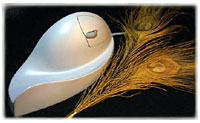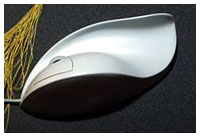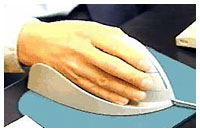I've been using a couple of Quill
mice (both right hand and left hand models) for about five months now
and continue to be most favorably impressed with how comfortable this
somewhat radical (but attractive) mouse design is.
Torbay Holdings Inc. calls the Quill the "world's first
biomechanically engineered computer mouse." It is designed to help
minimize Repetitive Strain Injury (RSI).
The Quill is a gripless mouse that allows you to move the pointer
without holding it, so your hand is relaxed. For mousing with
conventional computer mice, one has to grip the mouse with a certain
amount of muscle pressure and exert more pressure on the mouse button
or buttons for clicking. The stress may seem small, but it builds up
over long computer sessions, and the on-off motion of clicking
involves nerve impulses combined with repeated muscle tensing and
relaxing, which is irritating to soft tissues and nerves, at least to
the extent.
 By
orienting the hand into the handshake position, the Quill not only
removes "twist" from then arm - thus "unwinding" the median nerve,
but also removes the usual "bend" of the wrist that users adopt when
the mouse is lower than the arm. The "handshake" position guides the
user into having the forearm at the same height as the mouse. The
Wrist Guide then maintains the arm/wrist/hand configuration within
biomechanically sound degrees of flex.
By
orienting the hand into the handshake position, the Quill not only
removes "twist" from then arm - thus "unwinding" the median nerve,
but also removes the usual "bend" of the wrist that users adopt when
the mouse is lower than the arm. The "handshake" position guides the
user into having the forearm at the same height as the mouse. The
Wrist Guide then maintains the arm/wrist/hand configuration within
biomechanically sound degrees of flex.
Computer mouse related RSI commonly results in pain, burning,
swelling, weakness, tingling, numbness, and a loss of dexterity in
the afflicted limb. People who use computers a lot are most at risk,
because hours spent gripping non-biomechanically designed mice really
adds up. Twisting the forearm (crossing the radius and ulna bones)
and allowing the wrist to freely flex over extended periods creates
the physiological changes resulting in reduced blood flow and a
deviation in the path of the median nerve, which puts unnecessary
load on it.
Torbay maintains that other mouse design attempts at reorientation
of the hand into the handshake position, the so called "vertical
mice" do not solve the critical "wrist flex" issue, and they are
still "gripping" - not gripless mice, as they do not provide support
for the base of the hand. The hand has to be under biomechanical load
just to move the mouse over the mousing area.
The Quill gripless mouse actively addresses all of these issues,
allowing the mousing hand to be relaxed when actually mousing. The
Quill gripless design maintains your mousing hand in the "neutral" or
"untwisted" low biomechanical load position without requiring you to
change the way you work. At the same time the Quill manages the
degree of flex of the wrist and provides a support and "vehicle" for
the hand when mousing.
This "vehicle," the mound and gully aspect to the design form the
gondola region of the Quill. The Quill is not only visually elegant,
but by placing your hand into the gondola of the Quill you make the
gripless biomechanical connection between you and your computer, so
you are no longer on the Web, you are in it, "surfing on a
gondola."
The gondola also makes moving the Quill almost effortless, as both
the hand and the wrist are supported in whatever direction you move
the Quill, providing a surface to push with the bulk of your hand so
there's no need to drag the mouse, requiring you to grip or use your
fingers or thumbs, as it is gripless. Also, your hand is never in
contact with the mousepad, which eliminates the problem of skin oil
and dirt buildup.
You position your hand on the Quill with the middle finger tip
towards the end of the lower button and your hand settled comfortably
into the contoured rest. The tip of your index finger may extend
slightly forward of the upper button, but his is quite comfortable.
The design of the buttons is center hinged, so the entire switch can
be actuated from any position, accommodating variance in finger
lengths. Button actuation is very light and can be achieved by a
slight bending of the finger. The scroll wheel can be rolled with the
inside of the middle or index finger.
Most of the mouse tracking movement with the Quill is made from
the elbow and shoulder rather than from the wrist or fingers. It
takes some getting used to and is not as precise as fine motor
movements of the hand, but it is less stressful and more comfortable
once you have become acclimatized.
The Quill is larger than most other mice - certainly the largest
I've ever used - but it is also amazingly light for its size. (Light
weight is one reason why the Quill is corded rather than cordless -
no batteries required.) The extra area is under the region normally
occupied by the hand. The Quill is optical, so there's no trackball,
and there is zero maintenance required other than cleaning the hand
contact surface from time to time.
The Quill mouse tracks accurately and precisely, and the three
buttons and scroll wheel are convenient in OS X, where they are
supported. All the buttons revert to a standard click in OS 9,
and the scroll wheel does not work, although it may be possible to
enable it with a third party driver like USB
Overdrive. I did not test this. (The Quill mouse also comes
with a PS/2 adapter for use with non-USB equipped PCs)
At US$120/Can$195, the Quill isn't cheap, but you are provided
with what could be a comfortable solution to a problem that torments
those who work hard at their chosen profession or recreation.

 By
orienting the hand into the handshake position, the Quill not only
removes "twist" from then arm - thus "unwinding" the median nerve,
but also removes the usual "bend" of the wrist that users adopt when
the mouse is lower than the arm. The "handshake" position guides the
user into having the forearm at the same height as the mouse. The
Wrist Guide then maintains the arm/wrist/hand configuration within
biomechanically sound degrees of flex.
By
orienting the hand into the handshake position, the Quill not only
removes "twist" from then arm - thus "unwinding" the median nerve,
but also removes the usual "bend" of the wrist that users adopt when
the mouse is lower than the arm. The "handshake" position guides the
user into having the forearm at the same height as the mouse. The
Wrist Guide then maintains the arm/wrist/hand configuration within
biomechanically sound degrees of flex.



